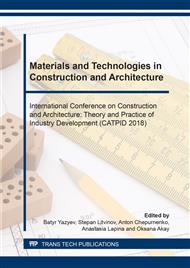[1]
D. E. Barabash, Effective sealing material on the basis of modified rubber, Building materials. 4 (2008) 71-75.
Google Scholar
[2]
Yu. M. Borisov, A. E. Polikutin, Nguen Fan Dhuy, Investigation of bearing capacity of normal sections of two-layer, rubcon-concrete bending elements, Bulletin of the Central regional office RAASN: collection of scientific articles. 9 (2010).
Google Scholar
[3]
Yu. M. Borisov, A. E. Polikutin, Nguen Fan Dhuy, The Stress-strain state of normal sections of two-layer, rubcon-concrete bending elements of building structures, Scientific Herald of VSACE Architecture and construction,. 2 (2010) 18-24.
Google Scholar
[4]
Yu. M. Borisov, D. V. Panfilov, S. V. Kashtanov, Ye. M. Yudin, Construction disperses reinforced composites, Structural mechanics and design. 2 (2010) 32-37.
Google Scholar
[5]
Yu. M. Borisov, A. E. Polikutin, A. C. Chudinov, A. Y. Atanov, Objectives and methodology of experimental studies of the normal sections of bending elements T-profile from armorubcon, Scientific Herald of the Voronezh state University of architecture and construction. Series: High technology. Ecology. 1 (2011).
Google Scholar
[6]
Nguyen Phan Dhuy, Double-layered, rubcon-concrete bending elements of building structures, Diss. PhD of tech. sciences: 05.23.01, Voronezh, (2010).
Google Scholar
[7]
D. V. Panfilov, Dispersed reinforced building composites based on polybutadiene oligomer , Diss. PhD of tech. sciences: 05.23.05, Voronezh, (2004).
Google Scholar
[8]
O. E. Perekalsky, Building composites based on polybutadiene oligomers for radiation protection, Diss. PhD of tech. sciences: 05.23.05, Voronezh, (2006).
Google Scholar
[9]
S. A. Pinaev, Short compressed elements of building structures from an effective composite based on butadiene polymer, Diss. PhD of tech. sciences, Voronezh, (2001).
Google Scholar
[10]
A. E. Polikutin, Strength and crack resistance of oblique sections of bending elements of building structures from armorubcon, Diss. PhD of tech. sciences: 05.23.01, Voronezh, (2002).
Google Scholar
[11]
Yu. B. Potapov, High-performance composites based on liquid rubbers, in: Materials of international scientific-technical conference (IV Academic reading RAASN) Actual problems of construction material science,: collection of scientific works, Penza, 1998, pp.16-17.
Google Scholar
[12]
Yu. B. Potapov, Rubcon – a new class of corrosion resistant construction materials, Building materials of the XXI century. 9 (2000) 9-10.
Google Scholar
[13]
O. L. Figovsky, Yu. B. Potapov, D.V. Panfilov, S. V. Kashtanov, E. M. Yudin, Study of the distribution of defects in the structure of fibro rubber concrete of Monte-Carlo method, Eastern European journal of enterprise technologies. 11 (2014).
DOI: 10.56431/p-0899gk
Google Scholar
[14]
V. A. Chmykhov, Rubber concrete resistance to aggressive environment, Diss. PhD of. tech. sciences: 05.23.05, Voronezh, (2002).
Google Scholar
[15]
Yu.B. Potapov, S.A. Pinaev, A.A. Arakelyan, A.D. Barabash, Polymer-cement material for corrosion protection of reinforced concrete elements, Solid State Phenomena. 871 (2016) 104-109.
DOI: 10.4028/www.scientific.net/msf.871.104
Google Scholar
[16]
S. N. Zolotukhin, O. B. Kukina, A. A. Abramenko, V. Ya. Mishchenko, Changes over time in the structure, properties, state of large-scale waste-stale phosphogypsum dehydrate, Journal Scientific, practical and methodological Finance, Economics, Strategy, Voronezh, 2017, pp.69-77.
Google Scholar
[17]
SP 52-104-2006*, Steel fiber concrete construction (with amendments and additions), Developed by the research, design and technological Institute of concrete and reinforced concrete (NIIZHB im. A. A. Gvozdev), (2006).
DOI: 10.31659/0585-430x-2018-765-11-15-20
Google Scholar
[18]
SP 20.13330.2016, Loads and impacts. The updated edition of SNiP 2.01.07-85*, Developed by CNIISK im. V. A. Kucherenko, (2016).
Google Scholar


